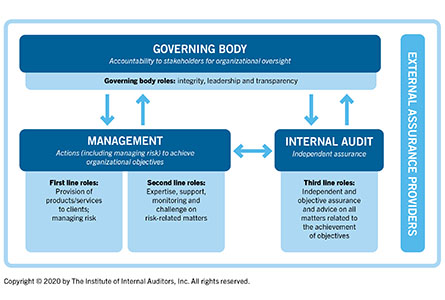
New IIA Three Lines Model Offers Timely Evolution of a Trusted Tool
July 20, 2020
5 Things Internal Audit Must Tell the Audit Committee Now!
August 3, 2020To say the effects of COVID-19 have been significant for organizations large and small is to state the obvious. Each day brings fresh insights about control weaknesses, costly failures, and new risks exposed by the pandemic and its many related affronts.
It is also obvious by now that many organizations have responded admirably to counter these effects. They reacted nimbly to initial lock downs by adapting processes and embracing technology to ensure continued productivity. They balanced creative new approaches to business with socially responsible actions to soldier through the pandemic safely.
Internal audit has proven its value in this crisis, as well. IIA surveys find that internal auditors are adapting to the needs of their organizations, often taking on nontraditional roles and exhibiting noteworthy flexibility in updating risk assessments and revising audit plans as part of pandemic responses.
But even as we find and celebrate successes in adapting to this scourge, we must recognize that decisions are being made often with limited information and with short-term goals in mind. Indeed, long-term strategies can easily be put off amid the storm of new risks and challenges that emerge and threaten at breakneck speeds.
The list of pandemic-related risk areas where internal audit is providing assurance and advice is long: crisis planning, business continuity, cybersecurity, third-party relationships, employee health and productivity, and more. We must consider that the quality of internal audit’s work may be compromised, as practitioners scramble to respond to their organizations’ needs often isolated or limited in their ability to conduct on-site assessments. One of the clearest threats to quality is in failing to dig deep enough to expose the root causes of control failures and weaknesses.
I wrote about the folly of superficial findings in a blog post several years ago titled, “Good Internal Audits Focus on the Roots, Not Just the Trees.” Many of the observations in that post hold true today. From the post:
As internal auditors, we are often tempted to stress in our reports the conditions we observe. After all, conditions that result from risk management or control failures can often be described in compelling terms. A failure of a new IT system, a key compliance requirement, or a critical financial control are sure to rivet the attention of management and the board. Internal audit reports also frequently include in-depth discussions of the effects associated with the conditions. After all, the only thing more sensational than describing something that is broken is regaling the reader with all of the consequences of the breakage.
While reports that include extensive narrative on conditions and effects can make for great prose, they often fall short of adding real value. I once had a manager who readily admitted that he had problems. He pleaded with me at the outset of the audit not to come back and tell him what he already knew. In his words, “I don’t need someone to come in here and tell me I have problems. I know I have problems. I need someone who can tell me how to fix them.” It was the recommendations that would be included in the report that would help him the most.
Criteria (what should have been), conditions, effects, and recommendations are often cited among the core elements of “audit findings.” But there is another element that is often the least understood, and perhaps the most critical: the cause (or root cause) of the conditions. Without understanding the cause, it is virtually impossible to offer sound recommendations for corrective actions.
In the blog post, I cited the U.S. Government Accountability Yellow Book auditing standards and quoted its guidance on identifying the cause associated with an observed condition.
“The cause identifies the reason or explanation for the condition or the factor or factors responsible for the difference between the situation that exists (condition) and the required or desired state (criteria), which may also serve as a basis for recommendations for corrective actions. Common factors include poorly designed policies, procedures, or criteria; inconsistent, incomplete, or incorrect implementation; or factors beyond the control of program management. Auditors may assess whether the evidence provides a reasonable or convincing argument for why the stated cause is the key factor or factors contributing to the difference between the condition and the criteria.”
Finally, I pointed to an IIA Practice Advisory on root-cause analysis — now part of Implementation Guide 2320, available for download to all IIA members — that offered a simple process that centers on asking “why”.
“The worker fell. Why? Because of oil on t he floor. Why? Because of a broken part. Why? Because the part keeps failing. Why? Because of changes in procurement practices.” Why?
It’s imperative that internal auditors craft findings that include each of the five C’s — Criteria, Condition, Consequence/Effect, Cause, and Corrective Action/Recommendation. But even as the five C’s are important in effective reporting, identifying root causes can be infinitely more valuable.
Now more than ever, having clear and accurate answers to the “whys” uncovered in each step of the audit process is critical. Digging deep enough to find root causes of control weaknesses and failures must be the top priority in all our engagements. The stakes are too high to accept anything less than our best work.
As always, I look forward to your comments.




I welcome your comments via LinkedIn or Twitter (@rfchambers).